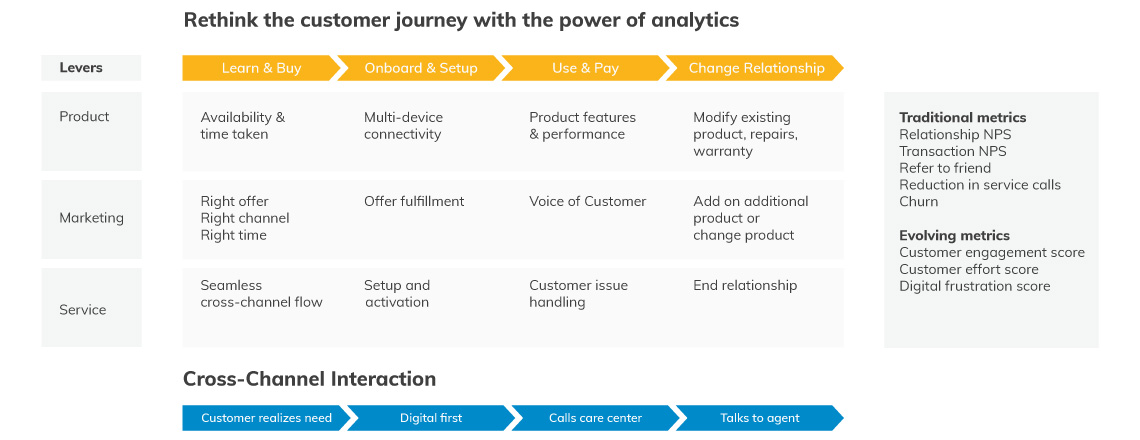Our POV

Along with recognizing and identifying the key drivers of satisfaction, it is also critical to predict customer issues to be able to prevent them from happening, wherever possible. Analytics are an essential element in being able to predict customer issues, proactively connect with individual customers resolve to their issues, and anticipate issues faced by customer that has purchased a new product.
For example:
State space algorithms are powerful tools in customer issue prediction. A branch of machine learning, state-space models are able to predict customer issues by learning from different events, customer characteristics, and recent behavior to enable proactive handling of the issues. Based on this insight you can understand the likelihood of different customers reaching out to the call center and how this relates to certain events.

In addition to marketing attribution models, the second dimension of marketing campaign ROI is the ‘message of the campaign’. Effective messaging that resonates with consumer needs is critical.
An effective approach is to perform ‘drivers analysis’, on customer-level survey data, to identify the drivers of customer satisfaction or overall equity. This approach identifies what product benefits consumers look for from a brand, quantifies the impact of each benefit on equity, and identifies the top benefits that matter most to consumers when they pick a brand.
This approach provides guidance to build effective communication and positioning strategies. It helps align product offerings with consumer needs and explore opportunities for new product introductions and filling the innovation pipeline.
This helps brands:
- Influence customer perception through effective communication and positioning strategies and alignment of product portfolio with customer needs
- Attract consumers from other brands and drive premiumization

Effective media execution demands complete views of marketing’s impact on sales. Traditional approaches to marketing mix modeling only capture short-term impacts. True marketing ROI also involves its long-term and indirect impacts.
The long-term impact involves three drivers that need to be measured with analytics:
- Improved brand equity strengthening base-line sales. Impact through brand equity framework identifies impacts of marketing on equity. Recommended approach.
- Repeat purchases from shoppers. Long-term lag of media framework measures sales against media lag. Secondary option.
- Willingness to pay by creating premium perception to increase prices. Variance in price elasticity framework captures the change in price-elasticity. Additional analysis.
The indirect impact of paid media accounts for its influence on earned media that drive sales.
Bayesian Networks capture media interactions, revealing how earned media is driven by paid media vehicles.
Cross-media analysis of the direct and indirect impacts reveals the total contribution of media activities, informing effective media execution.

Keeping customers happy means delivering value in every interaction along their journey. There’s a wealth of insight in your existing customer data. Analytics unlocks it to reveal how customers really feel about your brand, which ones aren’t happy, and where you can make a difference.
For example:
Unstructured and big data gets at the root of great experiences. Explain past, present and future interactions using text mining algorithms—on call center notes, complaints, and feedback—to reveal information on customer sentiment and why customers call. Mine structured big data on call ‘root causes’ to fix them where possible, and setup real-time notifications for client-led issues like service going down.
Machine learning reveals which customers are silently dissatisfied. Only about two percent of customers provide net promoter scores (NPSs). Machine learning can look at customers’ NPS scores and identify others like them, revealing how customers feel before they complain and make impactful interventions.

Effective personalized marketing means addressing many business questions around touchpoint attribution, such as what channels to adopt, at what point in time, and which prospect to target to maximize ROI. That means translating these questions into analytics objectives addressed through specific analytics approaches:
From the brand-level view:
- Allocating marketing budgets across touchpoints to maximize ROI means running analytics to attribute KPI success to various touchpoints.
- Understanding the right number and sequencing of touchpoints means using analytics to see how your propensity for success varies when increasing the number of instances on touch points.
From the customer view:
- Deciding whether to target a specific customer means using analytics to see if the customer is the right target.
- Identifying the next best customer action means analyzing the optimal path to success.
Getting there means selecting the best analytical methods to find the answers that drive marketing ROI.

There’s so many factors involved in what satisfies customers when interacting with your call center—from how long it takes to get their issues resolved to how many times they previously called. Delivering great experiences means identifying the true ‘direct and indirect’ drivers of customer satisfaction. Analytics is a powerful tool to make this happen by revealing the hidden connections between the factors of customer satisfaction.
It will enable you to enhance digital and interactive voice response experiences for quick and self-serve resolution of critical service issues. You’ll be able to drive process and programmatic improvements for high-priority customer needs and segments.
For example:
Bayesian Belief Networks are able to identify the true drivers of customer satisfaction. This helps you get to not just the direct, but also indirect, drivers of customer satisfaction through a probabilistic approach to help you drive focus in preventing and proactively handling specific customer experience issues.
Case Studies
-
 2 min. read
2 min. readIdentify growth opportunities across functions
A CPG identifies cross-functional growth drivers for net revenue management using Bayesian Networks.
The Big Picture A global CPG company needed to be able to predict and identify potential areas of growth that would apply to future scenarios in multiple markets and product lines (e.g., household detergent and food...
-
 2 min. read
2 min. readOptimize marketing planning and execution through advanced analytics
A telecom provider combines marketing attribution with key equity drivers for effective campaigns.
The Big Picture An India-based telecom service provider wanted to enhance the efficacy of their marketing campaigns by understanding how past campaigns have impacted key brand KPIs such as intention-to-purchase and...
-
 2 min. read
2 min. readOptimize product portfolios using Bayesian Regression analytics
A CPG optimizes its portfolio by exploring granular opportunities at variant and retailer levels.
The Big Picture A leading CPG manufacturer recently changed its messaging strategy from attribute-oriented to customer experience-oriented and thus wanted to compare the impact of its old messaging to its new messaging...
-
 2 min. read
2 min. readUse data visualization to monitor e-commerce performance
A CPG company deploys a dashboard to view e-commerce performance and improve decision-making.
The Big Picture A leading CPG company for baby foods recently started selling through its own and third-party e-commerce stores. While e-commerce contributed approximately 20% to 30% of sales across markets, there was...
-
 2 min. read
2 min. readEstimate locations of merchants and customers with transaction data
A financial institution uses customer transition patterns for location-based marketing campaigns.
The Big Picture A leading financial institution had visibility on the card transaction patterns of its customers but did not know where its customers’ home locations were, or the locations of the merchants where...
-
 2 min. read
2 min. readBuild effective communication and product strategies
A CPG manufacturer uses network models to identify key drivers and equity paths, across markets.
The Big Picture A leading brand in the men’s grooming category already had over 80% volume share in all key markets. The penetration of the category was close to 100% already, and hence the only feasible way to grow...
-
 2 min. read
2 min. readUnderstand the impact of media on customer web traffic and sales
An online marketplace uses cross-media network models to understand how media drives web visits.
The Big Picture An online marketplace uses cross-media network models to understand how media drives web visits. A regional division of a global online peer-to-peer marketplace wanted to understand the impact of...






